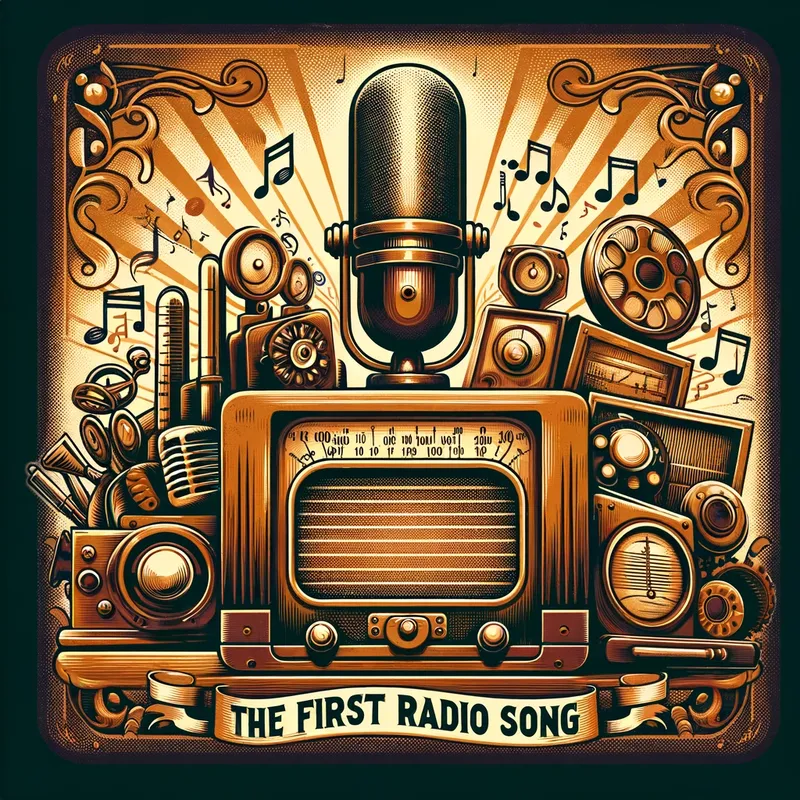The First Song On The Radio

Ever wondered what song had the honor of being the first ever to grace the airwaves?
Well, join us on this trip back to when the radio waves first sang.
Table of Contents
How it All Started: The Birth of Radio
In the late 19th and early 20th centuries, scientists and inventors were racing to develop wireless communication. The goal was initially to send Morse code without wires, not to serenade listeners.
A guy named Guglielmo Marconi is often credited with inventing the radio in the 1890s. He did make significant advances, but remember, science is a team sport, and many contributed to the radio’s birth.
The Voices Before the Song
Now, the first sounds transmitted on these early radios weren’t music. They were typically Morse code or voice experiments. The idea of regular broadcasting – sending out regular programs for anyone to tune into – was still in its infancy.
Many stations sprouted up in the early 1900s, but they were primarily experimental, used for communicating between ships or between a ship and a shore station.
The Surprising Debut
On Christmas Eve of 1906, Reginald Fessenden, a Canadian inventor changed radio forever. For the first time, radio wasn’t just dots and dashes or dry spoken words. Fessenden played a song on the violin – “O Holy Night.” He didn’t stop there. After finishing his performance, he picked up the story of Christ’s birth from the Gospel of Luke.
So, the first song was a live performance on the violin, which, when you think about it, is kind of poetic.
“O Holy Night”
Let’s unwrap the story behind this song and its groundbreaking radio debut.
Origins of the Song
“O Holy Night” roots dig deep into the 19th century. The song, originally in French and titled “Cantique de Noël”, was penned by Adolphe Adam in 1847. The lyrics came from a French poem, “Minuit, chrétiens” (Midnight, Christians) by Placide Cappeau.
Cappeau was asked by a parish priest to write a Christmas poem, and he approached Adam to set it to music. Thus, “Cantique de Noël” was born.
Its poignant lyrics and powerful tune resonated with many, but its journey wasn’t without controversy. Some French church authorities denounced it for lack of musical taste and “total absence of the spirit of religion”. Yet, the song’s popularity soared.
Journey Across the Atlantic
It didn’t take long for “Cantique de Noël” to cross over to the English-speaking world. In 1855, John Sullivan Dwight, a Unitarian minister and music critic, translated the song into English.
His version, which we know as “O Holy Night,” emphasized the song’s abolitionist themes, making it particularly resonant in the United States, which was grappling with the issue of slavery.
The Leap to Radio
Back to 1906 – why was “O Holy Night” chosen for such a landmark broadcast?
Well, the reasons aren’t documented, but considering its popularity and the fact that it was Christmas Eve, it does make a lot of sense. The song’s rich history of resonating with the masses due to its themes of hope and redemption made it an ideal choice for such an iconic broadcast.
Impact of the Song’s Radio Debut
Reginald Fessenden’s choice to play “O Holy Night” on the violin was indeed strategic. The song’s long, sweeping notes showcased the capabilities of voice transmission over radio waves, proving that music could be effectively broadcasted. It was a demonstration, a proof of concept about the potential of radio.
Moreover, the broadcast showed that radio could be deeply personal. Whereas previous broadcasts were largely technical or informational, this was something different: something that resonates with human emotion, being played live across vast distances.
But Wait… Was it Really the First?
There’s a bit of contention about what counts as the “first” song on the radio. Fessenden’s 1906 broadcast is often recognized because it was a scheduled broadcast that many ships at sea reported hearing. But there were earlier, more experimental broadcasts that played music before this.
Lee de Forest, an American inventor (and self-proclaimed “Father of Radio”), played phonograph records on the airwaves as early as 1906.
There were likely other instances of music played on the radio before 1906, but Fessenden’s Christmas Eve broadcast holds a special place because of its reach and impact.
Radio Evolves: From Experiment to Entertainment
With the success of the early broadcasts, the idea that radio could be a medium for entertainment began to take root. Early radio stations were often set up by newspapers, schools, or department stores. The intent? To sell radios, of course!
By the 1920s, the concept of the radio station as we know it began to emerge. Stations would have scheduled programming that included news, plays, comedy shows, and of course, lots of music.
The rise of radio changed the music industry forever. Before radio, you’d have to buy sheet music or see live performances to enjoy most music. But now? Hit songs could reach millions overnight. The idea of a “hit song” or “top 40” was born from this era.
From the jazz age to the rock ‘n’ roll era, the radio was at the heart of it all.
